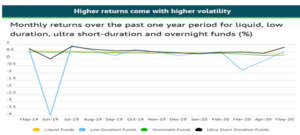An unrestricted debt proposal with a Macaulay duration of about 90 days-180 days is an Ultra Short Term Fund. If you are looking to invest your money for short durations, you should give Ultra Short Term Debt Mutual Fund a thought. It is perfect for the beginner if you have zero experience, and if you are a hasty person, you could invest in it and earn money within 3-6 months.
By investing in this mutual fund, you can have a constant income source if you have perfect SWP (Systematic withdrawal plan). You can also withdraw your money whenever you need it.
If you are looking for a habitual supply of revenue with reasonably inferior risks, then you should prefer Ultra Short Term Debt Mutual Fund since they are comparatively less fickle than equities. You could be more assured in this Debt Mutual Fund than in the comparison to Fixed Deposit (FDs). Since debt mutual funds offer more immeasurable returns with lower risks (for example, ultra short-term funds).
Ultra Short Term Mutual Fund
In this article
Ultra short-term funds (UST funds) come with an average maturity range of 6 months, but it could be 12-month in a special case. And they appeal to investors for investing in the incorporation of certificates of deposits, assets bills, marketable documents, and dealing bonds.
Typical maturity of the assortment, instruments glory eminence, significance fee, and the disbursement fraction of the relevant debt funds are some major aspects’ investors should evaluate before investing.
If we compare UFT returns with liquid debt funds, then it’s really high. And, UFT funds help investors by keeping them away from interest rates. Macaulay’s duration measures the time taken by the scheme to regain the investment.
Macaulay’s duration for Ultra short-term Debt Mutual funds is of 3-6 months.
Traits Of Ultra Short-term Debt Mutual Fund
Suitable for that investor who wants to invest their money for a short duration, the best ultra transient assets in India; are nearly insusceptible to loan cost chances because of short development of the basic resources when contrasted and different obligations reserves.
By Systematic Transfer Plans (STP), investors use the liquid funds to alter their investments, but for preliminary an STP, the UST fund can serve as an alternative. These funds are perfect for unadventurous investors.
Why Should You Invest In Ultra Short-term Debt Mutual Fund?
If you have a short-term financial goal, you should invest in an ultra-term debt mutual fund. Below is some advantage of investing money in ultra short term debt Mutual funds:
- Since it does not share any roots with the stock market, it is not affected by the equity market. The government protections, corporative obligation, and different protections like treasury bills and so on are the vast majority of the UST fund’s speculation.
- You can have your money in hand whenever you want. And, can choose the remaining money stay.
- For generating regular income, it’s a superlative investment source.
- You can make fixed money by having a systematic withdrawal plan (SWP). It is the opposite of a systematic investment plan (SIP). In a 30-day period, a fixed amount can be withdrawn.
Rules For Contributing To Ultra Short-term Debt Mutual Fund
Before you begin contributing, it is basic to get a thought of the separate contributing instrument, regardless of whether it satisfies your speculation thoughts and objective or not. Subsequently, putting resources into obligation shared assets, you ought to consistently affirm certain viewpoints beneath.
1. Match Time Horizons
Obligation finances offer individual decisions of a venture with their development period. Speculators need to choose money dependent on their development period. Simultaneously, they can likewise contrast and other obligation finance instruments and select the one that suits them best for their arrangement. For instance, if you are taking a gander at the time span of short of what one-year at that spot, ultra transient obligation assets can be fit.
2. Consider Interest Rate
The discerning business sector condition is exact in the red subsidizes; it incorporates the financing cost and its varieties. At whatever point the loan fee rises, security value falls, and the other way around.
The obligation reserves are presented to loan cost variety; it upsets the fundamental securities’ costs in the store portfolio. During this time, picking a momentary venture plan will bring down your loan cost dangers.
3. Expense Ratio
For paying off debtors reserves, the Expense proportion can be a significant factor. A much bigger effect can be done through a higher cost proportion.
Handpicked Ultra Short Term Debt Mutual Funds
1. ICICI Prudential Ultra Short Term Debt Mutual Fund Direct-Growth
a. Fund recital: 8.47% was the profit for the most recent year. And, 8.13% was the benefit year for this reserve in the past three years.
b. Why contribute: It is one of the most astonishing Debt mutual funds in India, and it has outflanked other comparable assets. For the latest year, the profit was 8.47%—₹ 5,000 minimal measure of the single amount required to supply in this plan. The littlest SIP speculation sum required for this plan is of ₹1,000.
2. PGIM India Ultra Short Term Debt Mutual Funds
a. Performance: 12.35% was the profit for the newest year. And, 9.68% was the benefit year for this reserve in the past three years.
b. Why invest: It is one of the most astonishing Debt mutual funds in India, and it has outflanked other comparable assets; for the latest year, the profit was 12.35%. ₹5,000 minimal measure of the single amount required to supply in this plan. The littlest SIP speculation sum required for this plan is ₹500.
3. Mahindra Manulife Low Duration Fund Direct-Growth
a. Fund recital: 8.62% was the profit for the newest year. And, 7.98% was the benefit year for this reserve in the past three years.
b. Why endow: It is one of the most stupendous Debt mutual funds in India. This fund has persistently outperformed other comparable funds, providing 8.62% returns to the previous year. ₹1,000 is the smallest amount of lump-sum required to endow in this scheme. The littlest SIP speculation sum required for this plan is ₹500.
4. Aditya Birla Sun Life Savings Direct-Growth
a. Fund Performance: 8.42% was the profit for the newest year. And, 7.94% was the benefit year for this reserve in the past three years.
b. Why invest: It is one of India’s most terrific Debt mutual funds, and it has outflanked other comparable assets. For the latest year, the profit was 8.42%. The lowest amount of lump-sum required to endow in this scheme is of ₹1,000. The littlest SIP speculation sum required for this plan is of ₹1,000.
5. Indiabulls Ultra Short Term Direct Fund Growth
a. Fund Performance: 7.61% was the profit for the newest year. And, 7.63% was the benefit year for this reserve in the past three years.
b. Why invest: It is one of India’s most outstanding Debt mutual funds, and it has outflanked other comparable assets. For the latest year, the profit was 7.61%. ₹500 is the smallest amount of lump-sum required to endow in this scheme is. And, ₹500 is the least SIP investment sum required for this scheme.
6. Invesco India Ultra Short Term Direct Fund Growth
a. Fund Performance: 7.66% was the profit for the newest year. And, 7.69% was the benefit year for this reserve in the past three years.
b. Why invest: It is one of India’s most bizarre Debt mutual funds, and it has outflanked other comparable assets. For the latest year, the profit was 7.66%. The smallest amount of lump-sum required to invest in this scheme is ₹1,000. The merest SIP investment amount mandatory for this scheme is ₹1,000.
7. YES Ultra Short Term Debt Mutual Fund Direct-Growth
a. Fund presentation: 5.44% was the profit for the newest year. In the debt segment, it has interminably hit its benchmark.
b. Why to spend: It is one of India’s most bizarre Debt mutual funds, and it has outflanked other comparable assets. For the latest year, the profit was 5.44%. ₹500 is the smallest amount of lump-sum required to invest in this scheme and the mandatory merest SIP investment amount.
8. Kotak Savings Fund Direct-Growth
a. Fund Performance: In the debt segment, it has interminably hit its benchmark. In the endmost year, its tax return was 7.97%. And, 7.75% was the benefit year for this reserve in the past three years.
b. Why invest: It is one of India’s most surprising Debt mutual funds, and it has outflanked other comparable assets. For the latest year, the profit was 7.97%—₹ 5,000 minimal measure of the single amount required to supply in this plan. ₹1,000 is the merest SIP investment amount mandatory.
9. Canara Robeco Savings Fund Direct-Growth
a. Fund Performance: In the endmost year, its tax return was 8.36%. And, 7.64% was the benefit year for this reserve in the past three years.
b. Why invest: It is one of the most amazing Debt mutual funds in India, and it has outflanked other comparable assets. For the latest year, the profit was 7.97%—₹ 5,000 minimal measure of the single amount required to supply in this plan. The merest SIP investment amount mandatory for this scheme is ₹1,000.
10. SBI Magnum Ultra Short Duration Fund Direct-Growth
a. Fund Performance: In the endmost year, its tax return was 7.87%. And, 7.78% was the benefit year for this reserve in the past three years.
b. Why invest: It is one of the most astonishing Debt mutual funds in India, and it has outflanked other comparable assets. For the latest year, the profit was 7.87%—₹ 5,000 minimal measure of the single amount required to supply in this plan. The littlest SIP speculation sum required for this plan is ₹500.
Debt Fund v/s Fixed Deposit
Fixed Deposits (FDs) are more preferable over any market-linked investments. It’s because of the guaranteed returns and the security of speculation they give. Debate mutual funds offer more immeasurable returns with lower risks (for example, ultra short-term funds). We will see some driving contrasts between these two road obligation reserves and fixed stores for more leeway.
1. Taxation
For an individual in a fixed deposit, the total income is taxable at the applicable cutting rate. On the off chance that you hold a venture for more than a 36month, you are charged at 20% with an indexation advantage of cost in the event of obligation reserves.
2. Returns
The loan cost for your store is pre-chosen in FDs still for obligation reserves, no financing cost is chosen.
3. Tax Deduction at Source (TDS)
In the debt assets, no TDS is deducted on your return to the event of FDs. You should pay TDS to a bank if your advantage beats INR 10,000/ –
4. Liquidity
In 1 or 2days’ notification, FDs can be emancipated regularly; it conveys a fine whenever reclaimed before the development date. Debt funds also have exit load assessments mostly levied for redemptions, typically up to three years. Ultra-short funds do not have any exit load. If they do have an exit load, it is for a concise period.

FAQs
1. Is it safe to invest in Ultra Short Term Debt Mutual Funds?
2. What is the difference between a liquid fund and an ultra short term debt mutual fund?
3. How do ultra short term debt mutual funds work?
4. Can we invest in mutual funds for 1 month?
5. Can I invest in a mutual fund for 1–day?
6. Are mutual funds more elegant than bank fixed deposits?



Leave a Reply